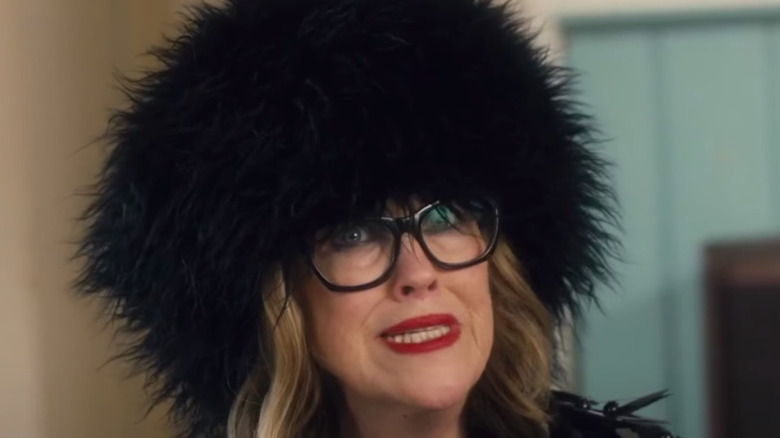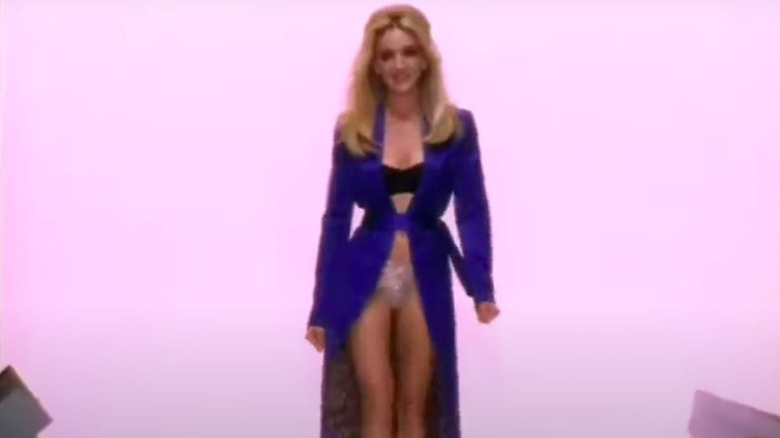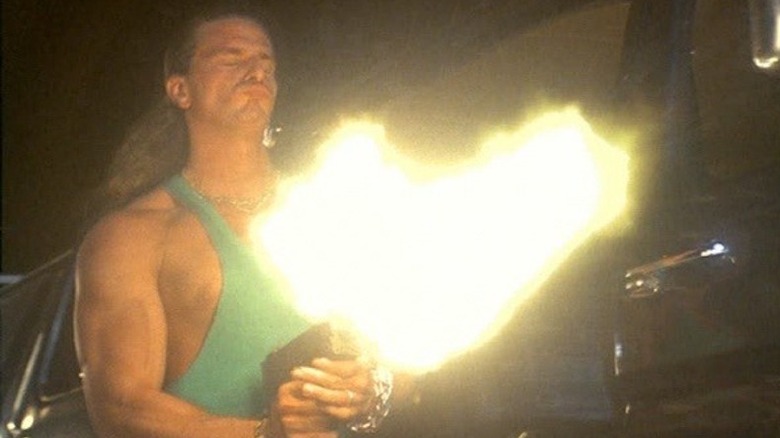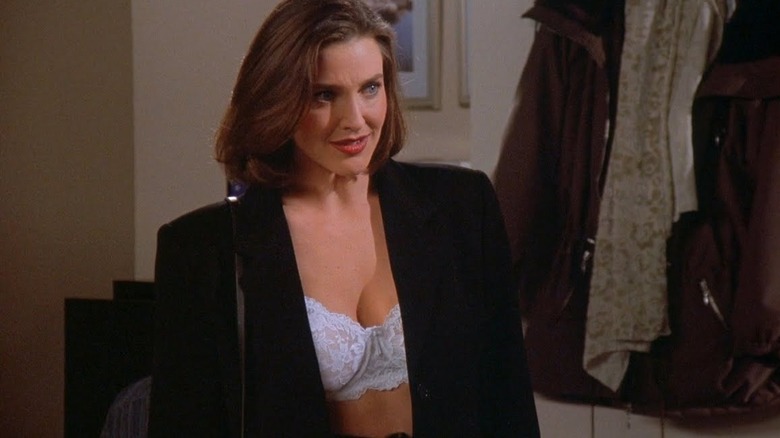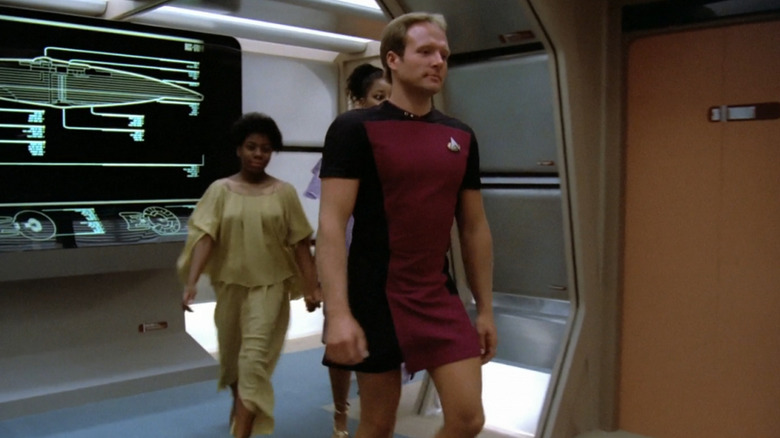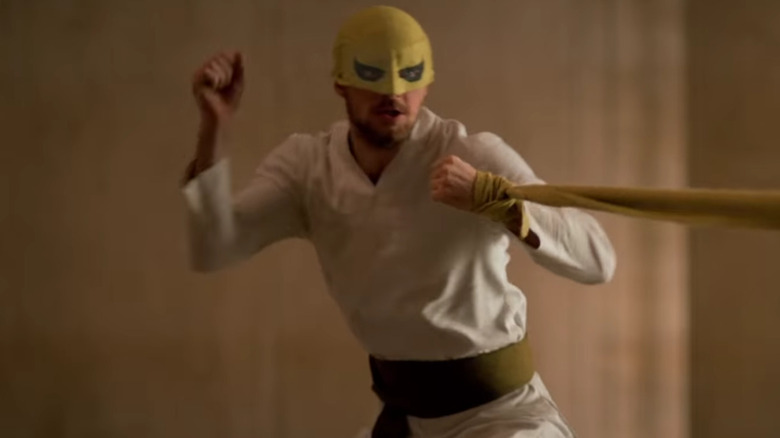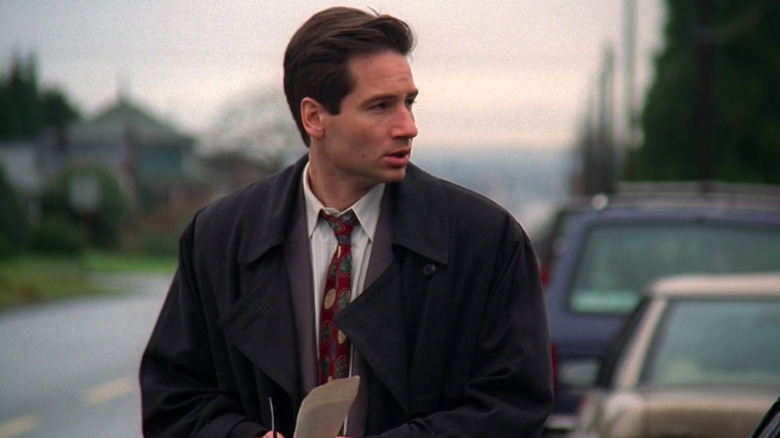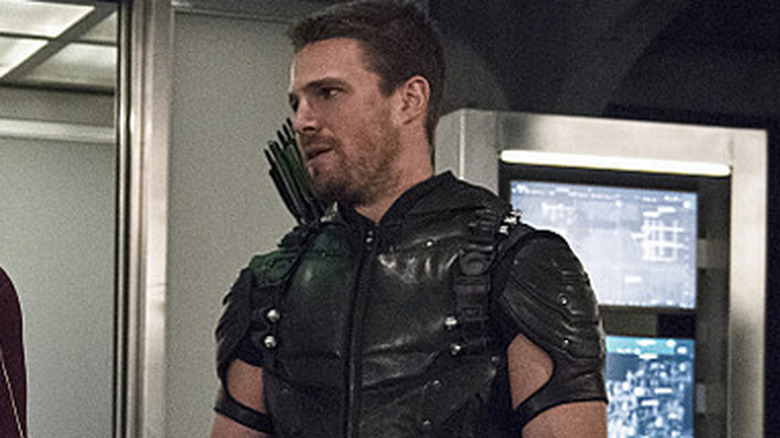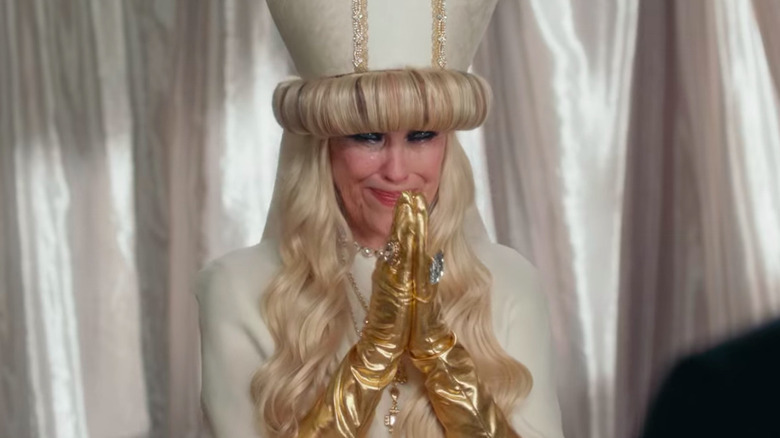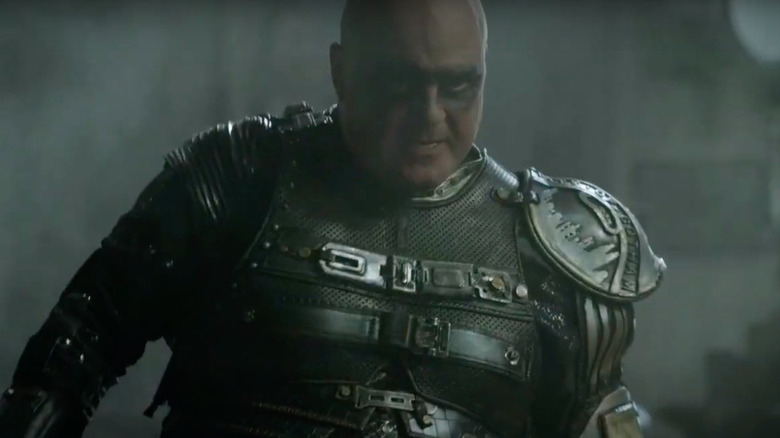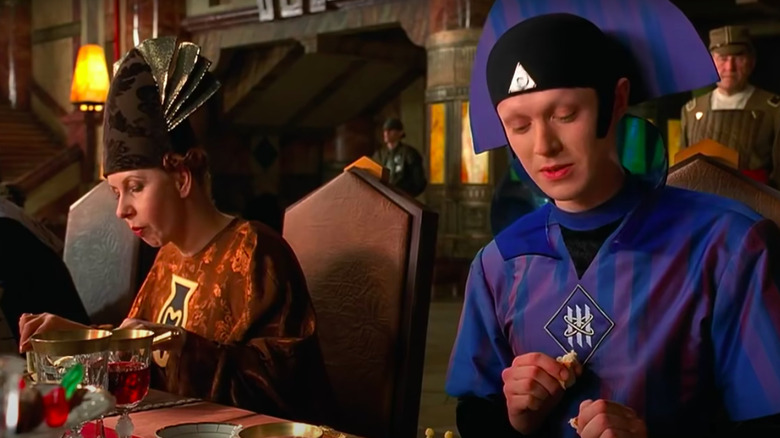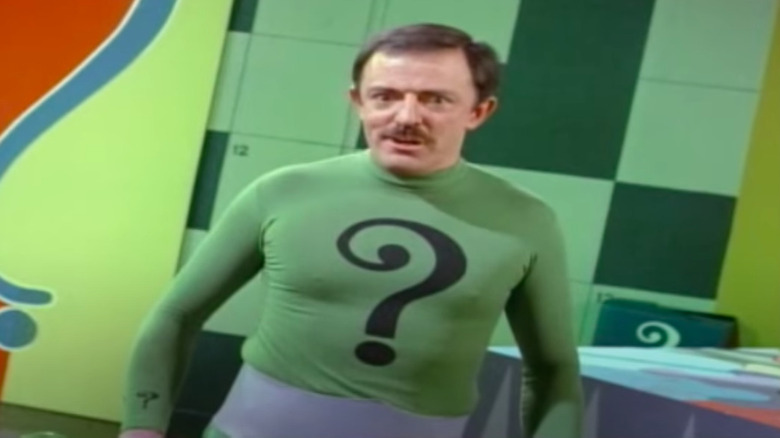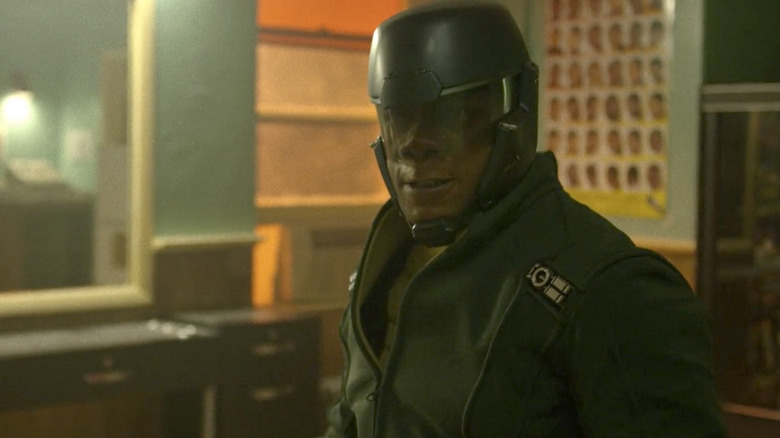TV Costumes That Took Things Too Far
Television is a visual medium, so looks matter. Actors go to painstaking lengths and make tremendous efforts to look their best, and in turn, they wear costumes that help to transform them into their characters. Stars don't just slap on some clothes to become their alter egos; entire teams of wardrobe experts design clothes that help the actors, the writers, and the directors to convey the story of any given piece of media.
Sometimes, something goes wrong in the costuming process. Every once in a while, the creators take a chance on a particular piece of clothing, and things spiral out of control. They say a person has to wear a suit and not let the suit wear them. Sometimes, an actor doesn't wear a costume. Sometimes, the costume wears the actor. These costumes from beloved television shows took things too far — and not always in a good way.
Carrie's bejeweled underwear in Sex and the City
We don't know what's worse: Carrie falling flat on her face during her first-ever runway walk or her wardrobe during the infamous tumble. In Season 4, Episode 2 titled, "The Real Me," Carrie (Sarah Jessica Parker) is invited to participate in a charity fashion show alongside Heidi Klum and former Mayor Ed Koch (both of whom appear as themselves!). Still, while she's enamored with the bejeweled panties she is tasked with modeling, it's difficult to fathom why.
The idea of having one's groin area literally sparkling with the radiant reflections of diamonds in the light is a romantic notion, but that doesn't explain Carrie's puffed-up hairdo or knee-length glam jacket, two elements that combine to make her look like a private detective in a porn movie. "Sex and the City" was always one of the most fashion-forward shows, but this getup was an absolute disaster. Still, at least Carrie was able to stand up after her fall and finish her runway walk without further incident.
Arzola's misshapen tank-top in Miami Vice
To be fair, this whole list could comprise of nothing but entries from "Miami Vice," such was the glorious audacity of that groundbreaking series' sense of style. However, the honors have to go to actor Timmy Cappello, who appeared in the Season 3 episode "Theresa." He wears a bizarrely misshapen tank-top that's so ghastly he spends much of the show shirtless, which isn't exactly better. He also wears his hair in a particularly slick ponytail, which can't be good for his scalp. While set up as an intimidating thug, he's unceremoniously killed when he runs into traffic while trying to escape from protagonist Sonny Crockett (Don Johnson).
In addition to his work as an actor, Cappello is also an accomplished musician, best known for his skills on the saxophone. He's appeared in movies like "What's Love Got to Do with It" and "The Lost Boys," the latter of which features a memorable sequence in which he sings and plays saxophone on a cover version of "I Still Believe" by The Call.
Brenda 'Is a bra a top?' in Seinfeld
On "Seinfeld," Elaine's arch-nemesis, Sue Ellen Mischke (Brenda Strong), only appeared on four episodes, but she certainly made an impression. At first, she bothered Elaine due to her refusal to wear a bra, so Elaine got her one as a present — which she then wore as a top, with only a business blazer covering her underwear. By the end of the episode, the idea of wearing a bra as a top becomes a huge hit with the public, a trend that did not extend into the real world.
Sue Ellen's ample bosom, and Jerry's rubbernecking when he drives past her on the street, causes a car accident that leads to a trial that parodies the OJ Simpson case; when asked to put on the bra over her leotard, the underwear doesn't fit due to the additional clothing. This is a reference to one of the more memetic elements of OJ's trial: "If it doesn't fit, you must acquit." As a result, Sue Ellen goes unpunished for her crimes against fashion.
Star Trek: TNG's infamous 'skants'
In the future, there will be unisex minidresses. While his intentions were noble, "Star Trek: The Next Generation" creator Gene Roddenberry's idea of a unisex uniform for men and women ultimately proved to be something of a misfire for the science fiction series. His idea was simple: if women in Star Trek can wear pants like males traditionally do, then men should have an option that's equally unisex. Alas, the "skant," as it is called, looked silly in practice, with its tiny sleeves making wearers look like uncomfortable children.
The skant only made sporadic appearances in the early days of "TNG" and was quickly phased out, with all crew members wearing either pants or those wacky catsuits Marina Sirtis had to squeeze into. The most recent acknowledgment of the fashion misfire came in an episode of the animated "Star Trek: Lower Decks," where a character says of the skant, "We don't wear those anymore." Perhaps, if Riker or Picard had given the skant a chance, the fashion of "Star Trek" would have gone down a different path. As it is, the unisex minidress is just a footnote in sci-fi history.
The ceremonial masks in Iron Fist
Nearly every comic book movie or TV show runs into the same problem: how to portray superhero costumes in live-action. Most comic outfits consist of skin-tight spandex, a material that isn't terribly flattering on most human bodies. As a result, materials like leather are often used, since they look better on film. Additionally, colors are often dulled from their comic book counterparts, since overly-bright colors tend to look garish when placed in a real-world setting.
The Marvel Netflix shows sidestepped the problem by mostly ignoring the comic costumes altogether. Save for Daredevil's bulky armored suit and Punisher's bullet-proof vest, most of the other characters didn't wear anything resembling their comic book costumes, and Iron Fist was no different. While he leaned towards the two-tone combo of yellow and green in a nod to his comic book origins, Finn Jones' Danny Rand rarely wore anything but typical street clothes, even when fighting crime.
However, Season 2 does feature a "ceremonial outfit" that looks like a traditional martial arts outfit, though with a yellow mask ripped straight out the comics — and it ain't pretty. Sometimes, costumes that look great in comic books don't translate into live-action, and this is one such example. The second season of "Iron Fist" is a tremendous improvement from Season 1 in many respects, but it falters in its attempt to pay homage to comic book fashion.
David Duchovny's oversized jacket on The X-Files
As an FBI agent who spends most of his free time chasing Bigfoot, Fox Mulder can't be expected to maintain a chic fashion profile. But still, the early days of "The X-Files" saddled him with some ridiculously oversized trench coats that practically devoured him like some kind of monster made of cheap clothing. It makes sense, since the show was shot in chilly Vancouver for its first five seasons, but the sheer size of Mulder's jacket could be an X-File in and of itself.
Upon closer examination, the jacket is likely so large in order to accommodate another fashion faux-pas that hadn't quite been phased out by the early 1990s: the oversized shoulder pads on Mulder's suit jacket. Between the shoulder pads and the fact that David Duchovny is already a square-shouldered hunk to begin with, the jacket needs to be as absurdly huge as it is — but that doesn't mean it's not awful. With his fashion sense, it's no wonder it took until Season 7 for Mulder and Scully to finally share their first official kiss! Nevertheless, Duchovny became a major sex symbol of the 1990s, with Seventeen magazine famously calling him "The X-iest guy on TV"
Sleeveless Green Arrow
Oliver Queen, aka The Green Arrow, played by Stephen Amell across eight seasons of his own show and numerous crossover appearances with other CW heroes, wears a green leather ensemble that hides his identity while providing a degree of protection from physical blows. For the most part, the costume is chic and functional, allowing the righteous vigilante to look cool while kicking butt and fighting to "save this city," but the Season 4 variation didn't quite hit the bullseye.
Most glaringly, this costume is sleeveless. While ostensibly a means of showing off Amell's big, strong arms, it instead looks like they simply ran out of material while assembling the outfit. Plus, his arms are covered by long gloves and arm guards anyway, which defeats the point of being sleeveless in the first place. Furthermore, Oliver's shoulders are covered by big, rounded shoulder pads, which only serve to make him look more like a Ninja Turtle, rather than a Robin Hood-esque emerald archer.
Finally, the costume simply isn't green enough, but it's apparently supposed to be, since several nighttime fight scenes put a cheap CG filter over the costume to try to make it look brighter and more green. Fortunately, Season 5 righted the ship, ditching the bizarre CG overlay and adding sleeves to the costume, an addition which kept the shoulder pads from sticking out so much.
Moira's wedding outfit in Schitt's Creek
Moira Rose, played by Catherine O'Hara in the hit TV series, "Schitt's Creek," is the pure embodiment of "costumes that took things too far." Not an episode of the series goes by in which Moira doesn't wear a bizarre costume and horrific wig. Throughout the series, her insane outfits run the gamut from "absolute nightmare" to "actually pretty hot." For the grand series finale, in which Moira serves as the officiant for her son's wedding, she pulled out all the stops and wore the best/worst costume ever shown on the series.
Basically, the outfit is her take on The Pope, complete with a long gown and a giant papal hat. Her wig is relatively normal by her standards, though its blonde locks do inexplicably line the entire brim of the pope hat. The real zingers here are her golden gloves, complete with rings. Rings over gloves? That's the ultimate fashion sin. Regardless, Moira does a fantastic job with the wedding, which marks a beautiful and touching final chapter to the "Schitt's Creek" saga.
The Executioner's costume in Gotham
Erstwhile "The Shield" star Michael Chiklis joined the cast of Fox's Batman origin story, "Gotham," in its second season. He enters the series as Nathaniel Barnes, a no-nonsense, tough-as-nails cop with a checkered past, but when he is infected by a drop of blood from Mad Hatter's dead sister, he becomes something nastier. He becomes The Executioner, an original villain created for the show (though he does share a name with a one-off Batman foe).
As The Executioner, Barnes murders criminals, which inevitably puts him into conflict with the more ethically-minded Jim Gordon. He also starts dressing like a bartender at a BDSM club, which puts him in conflict with Looper. The Executioner wears Green Arrow-style greasepaint on his face over his eyes and adorns himself with armor that looks like something a Cenobite from "Hellraiser" might wear. The armor is provided to him by the Court of Owls organization, a secret society that has pulled Gotham's strings for generations. Maybe that's why they gave him a costume that looks like it's from a straight-to-video sequel to "Eyes Wide Shut."
Dune's distinct headwear
Decades before Denis Villeneuve turned "Dune" into a mega-budget Hollywood blockbuster, the Sci-Fi Channel aired "Frank Herbert's Dune," a TV miniseries version of the acclaimed 1965 novel. Produced on a budget of $20 million, the miniseries aired in 2000 and became a huge hit for the television network.
There are a wide variety of factions within the world of "Dune," and the miniseries' way of conveying these disparate allegiances was to give each group a different style of costume, usually accentuated by distinct headwear. Unfortunately, these costumes went way too far in their execution. Today, "Frank Herbert's Dune" is remembered mainly for its wacky costumes, particularly the hats worn by characters like Irulan, but honestly, nearly every character can be described as "fashion overkill."
"Frank Herbert's Dune" was followed by "Frank Herbert's Children of Dune," a miniseries that combines the plots of the novels, "Dune Messiah" and "Children of Dune," concluding the story of Paul Atreides.
John Astin's 1960s Riddler
One of Batman's most famous villains, The Riddler, became a breakout star on the 1960s Batman series starring Adam West as the Caped Crusader. In the first and third seasons of the show, Riddler is played by Frank Gorshin, who earned an Emmy nomination for his performance as the quizzical villain. However, for the character's appearance in Season 2, John Astin was cast in the role, presumably due to Gorshin being unavailable at the time.
While Astin, best known as Gomez from "The Addams Family," does a decent enough job as Riddler, he doesn't fill out the character's costume in quite the same way. Gorshin was an extremely skinny man, one of the few actors who could effectively wear a skintight leotard without looking unintentionally silly. John Astin, while not morbidly obese or anything, simply didn't have a body type that would be flattered by such a costume.
Decades later, when Jim Carrey played The Riddler in "Batman Forever," he wore a skintight leotard costume that paid tribute to Frank Gorshin's outfit. Thankfully, Carrey was just as skinny as Gorshin, so there were no unfortunate curves in his version, avoiding the pudgy fate of John Astin's brief tenure as The Riddler.
Diamondback's power suit in Luke Cage
In the Season 1 finale of "Luke Cage," villain Diamondback (Erik LaRay Harvey) dons a Hammer Industries battle suit for his final showdown with Luke Cage. While it's supposed to be an outfit that empowers its wearers to take on threats on the level of Iron Man and Captain America, it, unfortunately, looks like something that would be worn by a janitor on a space station. The square-jawed helmet isn't bad, but its bland color scheme makes Diamondback look more like a house painter during the Great Depression than a super-powered threat to New York City.
At the end of the day, the ugly costume works as something of an inside joke since it was created by Hammer Industries. Justin Hammer, played by Sam Rockwell in "Iron Man 2," is essentially a Tony Stark wannabe who lacks the vision and the fashion sense to create anything truly original. Thus, the powered suit looks like something out of a cereal box from the 1970s. To add insult to injury, Diamondback is finally defeated when the suit runs out of power, allowing Cage to deliver an unceremonious beatdown on the would-be Kingpin of Harlem.
